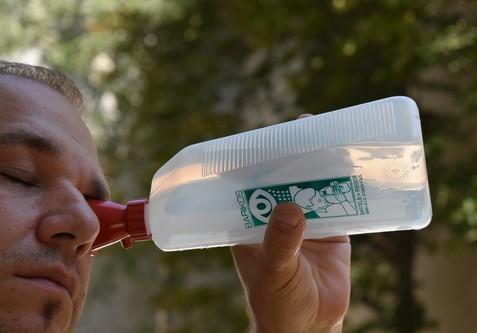Table of Contents
- Understanding the Immediate Effects of Pepper Spray on the Body
- Essential Steps to Perform First Aid Safely and Efficiently
- Recommended Cleaning and Decontamination Techniques
- When to Seek Professional Medical Attention After Exposure
- In Summary
Understanding the Immediate Effects of Pepper Spray on the Body
Pepper spray acts almost instantly upon contact with the eyes, skin, and respiratory system, causing an intense burning sensation that is both painful and disorienting. The primary active ingredient, capsaicin, triggers nerve endings, leading to a rapid onset of symptoms such as uncontrollable eye watering, severe irritation, coughing, and difficulty breathing. This immediate physiological response is designed to incapacitate by overwhelming sensory nerves, making it crucial to act swiftly in providing first aid. Awareness of these reactions can help in managing the victim’s distress and preventing escalation of symptoms.
Understanding these effects is essential for effective intervention. Common immediate symptoms include:
- Severe eye irritation resulting in involuntary blinking and temporary vision impairment
- Intense burning on the skin, which can extend beyond the sprayed area
- Inflammation of the respiratory tract leading to coughing, shortness of breath, and difficulty inhaling
- Excessive mucus production causing a runny nose and throat discomfort
Recognizing these signs quickly is vital to initiate appropriate first aid steps and minimize harm, helping the individual recover as safely and comfortably as possible.
Essential Steps to Perform First Aid Safely and Efficiently
When dealing with pepper spray exposure, immediate and calm action is crucial to minimize discomfort and prevent further injury. First, ensure the affected person moves to an open, well-ventilated area away from the source of the irritant. Avoid rubbing the eyes or skin, as this can worsen the irritation. Instead, gently flush the affected areas with large amounts of cool water or saline solution to help dilute the capsaicin compounds found in pepper spray. Using a clean, soft cloth, carefully dab around the eyes and face to remove residual powder without causing abrasion.
Essential safety precautions include:
- Protect yourself: Wear gloves to prevent cross-contamination when assisting others.
- Use sterile solutions: Avoid oils, creams, or lotions that can trap irritants and exacerbate symptoms.
- Support breathing: Keep the individual calm and upright; if respiratory distress occurs, seek emergency medical help immediately.
- Monitor closely: Watch for prolonged pain, swelling, or signs of allergic reaction, which may require professional intervention.
Recommended Cleaning and Decontamination Techniques
When dealing with pepper spray exposure, it is crucial to use the right cleaning methods to ensure effective decontamination without causing further irritation. Begin by flushing the affected area with large amounts of cool water for at least 10-15 minutes. Avoid using hot water, as it can intensify the burning sensation. Use a gentle, fragrance-free soap to help remove residual oils from the pepper spray, but be careful not to rub the skin harshly-patting gently is best to prevent additional irritation. If your eyes are affected, rinse them continuously with water or saline solution, keeping your eyelids open to flush out any particles thoroughly.
In addition to water and soap, certain neutralizing agents can aid in the cleaning process. Solutions containing milk proteins or specialized pepper spray removal wipes are effective in breaking down capsaicin, the active ingredient. However, always perform a patch test to avoid allergic reactions. Avoid using oils, creams, or harsh chemicals that may trap the irritant or worsen symptoms. Wearing disposable gloves during cleanup protects you and prevents further spread. For clothing contaminated with pepper spray, remove and wash garments separately with cold water, avoiding close contact until thoroughly cleaned.
When to Seek Professional Medical Attention After Exposure
While most pepper spray exposures can be effectively managed with basic first aid, certain symptoms indicate the need for immediate professional medical evaluation. If you experience severe respiratory distress, such as difficulty breathing, wheezing, or persistent coughing, it’s critical to seek emergency care without delay. Prolonged chest pain, fainting, or symptoms that worsen despite rinsing the affected area may also signal a more serious reaction that requires specialized medical intervention.
Watch for signs of allergic reaction or infection in the hours and days following exposure. If you notice extreme swelling, blistering, or eye pain that doesn’t improve, consult a healthcare provider promptly. Additionally, individuals with pre-existing conditions like asthma or heart disease should err on the side of caution and get checked out even if symptoms seem mild. Remember, timely medical attention can prevent complications and ensure a safe recovery.
- Severe or worsening breathing difficulties
- Persistent eye pain or vision changes
- Signs of allergic reaction: swelling, hives, or rash
- Chest pain, fainting, or confusion
- Pre-existing respiratory or cardiac conditions affected
In Summary
In conclusion, knowing how to respond quickly and effectively to pepper spray exposure can make a significant difference in minimizing discomfort and preventing further harm. By following the first aid tips outlined above-such as avoiding rubbing the affected area, rinsing thoroughly with water, and seeking medical attention when necessary-you can ensure a safer and swifter recovery. Remember, staying calm and acting promptly are key. Keep this guidance handy, and empower yourself to handle pepper spray incidents with confidence and care.Check Our Other Blogs
- StunGun – Your Trusted Source for Stun Guns, Laws, and Self-Defense Tips
- PepperSprayLaws – Your Trusted Resource for Pepper Spray Information
- StunGunLaws – Your Trusted Guide to Stun Gun Legality and Safety




